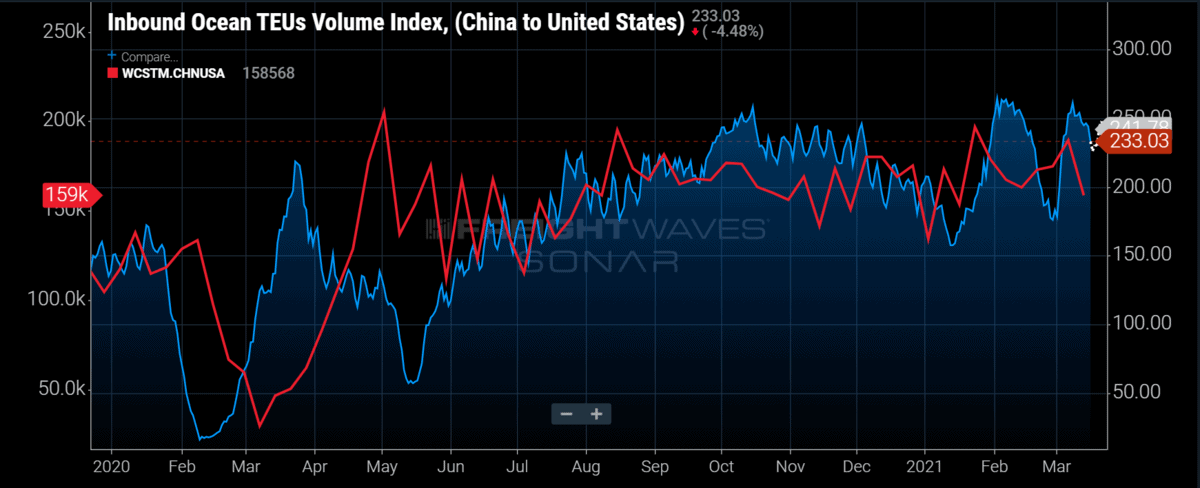The views expressed here are solely those of the author and do not necessarily represent the views of FreightWaves or its affiliates.
The third round of stimulus checks is starting to be disseminated. Based on the flow of trade, don’t expect the historic container congestion to end anytime soon.
According to the volumes of trade transported by SEKO US, there is a direct correlation to the stimulus checks and the surge in e-commerce spending.

“The combination of the shift of e-commerce driven by COVID and stimulus checks is what drove order volumes in December to January 2021 and February to March 2020,” explained Brian Bourke, chief growth officer of SEKO US. “Anything that shows an increase month-over-month versus year, as we saw in December to January, is most likely attributed to the stimulus checks.”
After the first round of stimulus checks in March 2020, Rick Lee, SEKO Logistics COO of North America, said the company saw e-commerce orders increase by more than 100%. After that first wave of increased orders, SEKO instituted a stimulus execution plan.
“As we have seen with the buying pattern after past stimulus checks, we are expecting similar consumer behavior with the third round of stimulus,” said Lee. “Our warehouses are working around the clock, and we are looking to add robotics as a supplement to the human component since shifts and social-distancing measures have been changed to protect our workers against COVID.”
SONAR Knowledge
Intermodal spread is the difference in the cost to ship one container from China to Chicago through the U.S. East Coast ports and the cost to ship one container from China to Chicago through the U.S. West Coast ports. Click here to learn more about this valuable SONAR data.
Container trade analysis by local and global transport and logistics research company MDS Transmodal show the yin and yang of trade. The first chart shows China’s continued dominance in exports; the second shows North America leading the world in imports.


“After the severe drop experienced by the international trade during the first half of 2020, global trade has proved its resilience, reporting an annual contraction in the region of 1% in contrast to the much bigger reduction feared by various economists at the beginning of 2020,” explained Antonella Teodoro, senior consultant at MDST. “… The increase has been supported by the emergency fiscal and monetary stimulus put in place by the wealthy economies.”
The pandemic has been a boon for Chinese exports and showcases the United States’ dependency on Chinese manufactured goods. In January and February of this year, Chinese exports have increased an incredible 60.6% compared to 2020. December saw growth of 18.1%, according to Chinese customs.

This tsunami of containerized trade has not only been costly for importers, it has crippled global port productivity. Based on the rates being paid, shippers are not receiving the quality service they are paying for. While the fourth quarter of 2020 saw the largest-ever quarterly volume of global container traffic, services performance plummeted.

Mike Garratt, chairman of MDS Transmodal, commented in its March edition of The Container Shipping Market Quarterly Review, “Annual volumes almost reached 2019 levels despite the pandemic, carried on a fleet capacity that had hardly changed. Demand growth was at its strongest on the east-west routes linking Far East manufacturers with consumers in North America and Europe.”
The slowdown has had some U.S. importers pivoting to the Panama and Suez canals to avoid the West Coast congestion. Demand for products from Asia is so great, capacity utilization reached 100% on headhaul services. This has driven the average revenue per container on the Far East-North America route by 20%.

Carriers are not the only winners in this movement of trade. It also provides opportunity for the East Coast ports, like the Port of Baltimore, to expand market share.
“Since mid-July, we have seen 16 extra loader ‘ad hoc’ container ships calls,” explained Bill Doyle, executive director of the Maryland Port Administration and Port of Baltimore. “That’s a total of 28,060 TEUs. E-commerce continues to be a driving factor in our recovery. With more consumers making online purchases, it is resulting in strong container gains for us.”
The Port of Baltimore is home to four distribution centers for Amazon, one of the largest benefactors of the COVID-19 buying boom.

“Tenants at the port and the surrounding area (distribution centers and warehouse retailers) are always hiring,” Doyle said. “We are also fortunate our dockworkers are doing well during COVID. We have had no major outbreaks. While we had a few days in February due to snow and ice conditions where we had delays, there is currently no wait at our port.”
The insatiable demand of the “I want it now” consumer continues to grow. Logistics managers will continue to find alternative routes to avoid congestion in an effort to restore a semblance of reliability. The strengths and weaknesses of port infrastructures throughout the United States will undoubtedly be tested.







